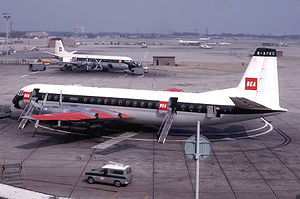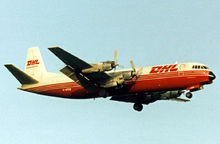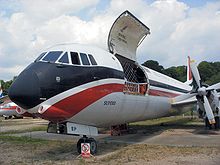Vickers Vanguard Video - Picture

|
|
Vickers Vanguard
Type 950 Vanguard

Picture - Vickers Vanguard (G-APEC) at London Heathrow Airport in 1965. This aircraft was built in 1959 and was lost (broke up in flight) in 1971.
Role: airliner
Manufacturer: Vickers-Armstrongs
First flight: 20 January 1959
Introduced: 1960
Retired: 1996
Primary users: British European Airways
Trans-Canada Airlines
Number built: 44
Developed from: Vickers Viscount
The Type 950 Vanguard was a British short/medium-range turboprop airliner introduced in 1959 by Vickers-Armstrongs, a development of their successful Viscount design with considerably more internal room. The Vanguard was introduced just before the first of the large jet-powered airliners, and was largely ignored by the market. Only 44 were built, ordered by Trans-Canada Airlines (TCA) and British European Airways (BEA). After only about 10 years service TCA experimentally converted one of theirs to a freighter configuration, calling it the Cargoliner. This was considered successful, and in the early 1970s most were converted to freighters, those from BEA becoming the Merchantman. These freighters remained in service for many years, with the last one (G-APEP) only retiring in 1996.
Design and development
The aircraft was designed to a BEA requirement for a 100-seat aircraft to replace their Viscounts. The original Type 870 design was then modified when TCA expressed their interest in the design as well, and Vickers returned the updated Type 950 that filled both requirements. The main difference between the Viscount and Vanguard was the construction of the fuselage. The Vanguard started with the original Viscount fuselage, but cut it off about half of the way up from the bottom, and replaced the top section with a larger-diameter fuselage to give it a double bubble cross-section (similar to the Boeing Stratocruiser). The result of the larger upper portion was a roomier interior, with increased cargo capacity below the floor.
With this larger, and heavier, fuselage came the need for a new engine to lift it. Rolls-Royce delivered their new Tyne design with a nominal 4,000 hp/3,000 kW (as compared to the Viscount's Dart of about 1,700 hp/1,300 kW). This allowed for a much higher service ceiling and cruising speed, the Vanguard had a service ceiling almost twice that of the Viscount. The Vanguard was one of the fastest turboprops ever and was faster than the present day Saab 2000 or de Havilland Canada Dash 8.
The first Type 950 prototype flew on 20 January 1959.
Operational history
The Vanguard entered service with BEA and TCA in late 1960. BEA operated their first Vanguard schedule on 17 December from Heathrow to Paris. Following delivery of their full fleet of six V951 and 14 V953 aircraft by 30 March 1962, the type took over many of BEAs busier European and UK trunk routes. The aircraft received names of famous Royal Navy warships, the first G-APEA was named "Vanguard", but these tended to be dropped later in service. Initial seating was 18 first-class at the rear and 108 tourist, but this was changed to 139 all-tourist, in which configuration, the Vanguard had very low operating costs per seat/mile. On flights up to 300 mi (480 km), such as from London to Paris, Brussels and Amsterdam, the type could match the block times of the pure jets which were being introduced in the early 1960s. The remaining BEA fleet passed to British Airways on 1 April 1974 and the last BA passenger flight with the type was on 16 June.
TCA initiated Vanguard schedules on 1 February 1961 with two flights from Toronto and Montreal via intermediate stops to Vancouver. The fleet was also used on services from Toronto and Montreal to New York and Nassau, Bahamas.
Cargo operations

Picture - V953C Merchantman of British Airways Cargo at Manchester in 1978
In 1966 Air Canada removed all the seats in CF-TKK and refitted the aircraft for pure cargo work, in which role it could carry 42,000 lb (19,050 kg) of freight. Known by the airline as the "Cargoliner," it was the only such conversion, but survived to be the last Canadian Vanguard to be retired in December 1972.
BEA operated nine Vanguards modified to the V953C "Merchantman" all-cargo layout from 1969, with the first two conversions being designed and carried out by Aviation Traders Engineering Ltd (ATEL) at Southend Airport. BEA modified the remainder at Heathrow using kits from ATEL. A large forward cargo door (139 in/353 cm by 80 in/203 cm high) was incorporated. The Merchantmen continued in service with BA until late 1979 when the remaining five were sold.

Picture - Merchantman of Air Bridge Carriers, in DHL colours, landing at Manchester Airport in 1992
Air Bridge Carriers purchased several of the Merchantmen and operated them until 15 August 1992, when their name was changed to Hunting Cargo Airlines. Hunting Cargo operated their last V953C flight on 30 September 1996 and donated G-APEP to Brooklands Museum on 17 October 1996; its final flight was expertly made by Gary West and the late Peter Moore.
Accidents and Incidents
On 27 October 1965, British European Airways Vickers Vanguard G-APEE flying from Edinburgh Airport to London Heathrow Airport, during a landing in poor visibility, attempted an overshoot but crashed on runway 28R. All on board died, 6 crew and 30 passengers.
On 2 October 1971, British European Airways Flight 706. operated by Vickers Vanguard G-APEC crashed near Aarsele in Belgium. The cause was the failure of the rear pressure bulkhead and subsequent destruction of the tailplane. All 8 crew and 55 passengers died.
On 10 April 1973, Invicta International Airlines Flight 435, operated by Vickers Vanguard G-AXOP crashed near Basel-Mulhouse Airport Switzerland. 4 crew and 104 passengers died.
On 29 January 1988, Inter Cargo Service Flight 1004, operated by Vickers Vanguard F-GEJF crashed on take-off from Toulouse-Blagnac Airport when take-off was attempted with only three fully operable engines.
On 6 February 1989, Inter Cargo Service Flight 3132, operated by Vickers Vanguard F-GEJE crashed on takeoff from Marseille-Marignane Airport, France. 3 crew died, no passengers carried.
Variants
Type 950
Prototype, one built and two fuselages were used as static test airframes.
Type 951
BEA, 20 ordered, six delivered. All in 127-seat, mixed class configuration (18 first and 109 economy)
Type 952
TCA, more powerful engine and stronger fuselage and wing for higher weights, 23 delivered
Type 953
BEA, Same engines as 951, but the stronger airframe of the 952. Mostly operated as 135-seater, all economy, but some configured as 127 mixed class the same as 951. A total of 14 delivered replacing an order for 951s.
Type 953C Merchantman
Nine Cargo conversions from Type 953
Operators
Canada
Air Canada
Trans Canada Airlines
France
European Aero Service
Inter Cargo Service
Iceland
Air Viking
Thor Cargo
Indonesia
Angkasa Civil Air Transport
Merpati Nusantara Airlines
Lebanon
Lebanese Air Transport
Sweden
Air Trader
United Kingdom
Air Bridge Carriers
Air Trader
British Airways
British European Airways
Hunting Cargo Airlines
Invicta International Airlines
Elan Air Cargo
DHL
Aircraft on display

Picture - Vickers Vanguard 953C Merchantman Superb at Brooklands Museum, Weybridge.
Type 953C Merchantman Superb (Registration G-APEP) at the Brooklands Museum, Surrey, England. The only intact airframe in existence.
Specifications (Type 952)
General characteristics
Crew: 2-3
Capacity: 139 passengers
Length: 122 ft 10 in (37.50 m)
Wingspan: 118 ft 7 in (36.10 m)
Height: 34 ft 11 in (10.60 m)
Wing area: 1,527 ft² (142 m²)
Empty weight: 82,500 lb (37,421 kg)
Loaded weight: 141,000 lb (63,977 kg)
Powerplant: 4x— Rolls-Royce Tyne RTy.11 Mk 512 turboprop, 5,545 hp (4,700 shp, 4,135 kW) each
Performance
Maximum speed: 425 mph (684 km/h)
Range: 1,830 mi (2,945 km)
Service ceiling: 30,000 ft (9,145 m)
Wing loading: 92 lb/ft² (450 kg/m²)
Power/mass: 0.16 hp/lb (0.26 kW/kg)
Comparable aircraft
Antonov An-10
Bristol Britannia
Ilyushin Il-18
Lockheed L-188 Electra
Bibliography
Davis, Peter W. Vickers Viscount and Vanguard. Tonbridge, Kent, UK: Air-Britain (Historians) Ltd., 1981. ISBN 0-85130-091-X.
Swanborough, F. G. Turbine-engined Airliners of the World. London: Temple Press Books, 1962.
Vickers Vanguard Pictures
Living Warbirds: The best warbirds DVD series.
Source: WikiPedia